 |

|
|
PROTO click is an accessory board in the mikroBUS form factor. It features a 10x11 prototyping area as well as additional power pads. It can be used to assemble custom electronics thus creating a custom "click" board. The board provides 3.3V and 5V power supply. PROTO click is a cheap and effective solution for creating click board of your own design. Add sensors, drivers, passive components and make the click board which suits your project needs. Use it with all your favorite development boards which carry mikroBUS sockets. |
|
|
|
 |

|
|
The SmartPROTO Board offers an effective and low-cost solution for connecting your prototype device to a PCB prototype board. It is connected to a development system or prototype device via an IDC10 connector. |
|
|
|
 |
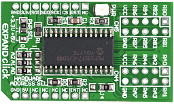
|
|
Expand Click is an accessory board in mikroBus form factor. It includes the MCP23S17 16-bit I/O expander, which features an SPI interface and clock speeds up to 10 MHz for higher throughput applications. Three HARDWARE ADDRESS SEL jumpers allow you to configure the board address and connect up to eight devices on the same bus. An interrupt-on-change feature is also supported, as well as optional weak pull-ups on each input. The board is set to use the 3.3V mikroBus power supply by default, however soldering the PWR SEL SMD jumper to the 5V position will allow it to be used with 5V mikroBus systems.
|
|
|
|
 |

|
|
EXPAND 2 click is an accessory board in mikroBUS form factor. It includes the MCP23017 16-bit I/O expander which features an I2C interface and clock speeds up to 1.7 MHz. Three HARDWARE ADDRESS SEL jumpers allow you to configure the board address and connect up to eight devices on the bus. The controller also supports an interrupt-on-change feature, and has optional weak pull-ups on each input. Expand2 click is set to use a 3.3V power supply by default but you can solder PWR SEL SMD jumper to the 5V position if used with 5V systems. |
|
|
|
 |

|
|
EXPAND 3 click carries DS2408, an 8-channel programmable I/O expander that communicates with the target board MCU through a standard Dallas Semiconductor 1-Wire interface (15.3 kbps or 100kbps). The chip also has a factory-lasered 64-bit registration number, which enables multiple EXPAND 3 clicks to be connected on the same data line. For this purpose, the click has additional three pins above the mikroBUS socket. As for the socket, the onboard GP SEL jumper allows you to specify the communication pins (either OW1 or OW0, which are in place of the usual AN and PWM pins on mikroBUS). An additional reset line (RST) is also connected. The board is designed to use either a 3.3V or 5V power supply. |
|
|
|
 |

|
|
Expand 4 click carries TPCIC6A595, a chip that combines an 8-bit serial-in, parallel-out shift register with an 8-bit D-type storage register. |
|
|
|
 |
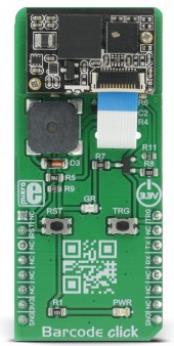
|
|
Barcode click is a very fast and agile barcode scanner on a click board™, which is compliant with a wide range of different 1D and 2D barcode protocols. The barcode scanner module is equipped with the micro USB port; thus, it can work both as a standalone device and a standard click board™, which communicates with the MCU via the RX, TX, RST and PWM pin of the mikroBUS™. The barcode module has two red LEDs, used to illuminate the area in low light conditions. Also, Barcode click features two push buttons, used to control the device when working as a standalone device. |
|
|
|
 |

|
|
RFid click is an accessory board in mikroBUS form factor. It is a compact and easy solution for adding RFid to your design. It features a CR95HF 13.56 MHz contactless transceiver as well as a trace antenna. RFid click communicates with the target board microcontroller via mikroBUS UART (TX, RX), SPI (MISO, MOSI, SCK, CS) INT, RST, PWM and AN lines. The board is designed to use a 3.3V power supply only. An LED diode (GREEN) indicates the presence of power supply. CR95HF IC is a RFid module with an integrated transceiver for contactless applications. The board contains a dedicated internal frame controller and analog front end (AFE) for RF communications. |
|
|
|
 |
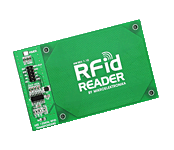
|
|
RFid Reader Board is a 125KHz RF transmitter and reciever, featuring the EM4095 controller chip. The reader has three main functions: energizing, demodulation and decoding. The reader can be connected to a microcontroller or PC for processing the data read from RFid tags. The signal is Manchester-coded. (An IDC10 cable is included with the board). |
|
|
|
 |
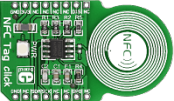
|
|
NFC Tag click carries an M24SR64 NFC/RFID tag IC with a dual interface and 8KB of high-reliability EEPROM built-in. The RF protocol is compatible with both NFC Forum Type 4 Tag and ISO/IEC 14443 Type A. There are three ways to operate NFC Tag click: 1) from an I2C interface; 2) by a 13.56 MHz RFID reader; or 3) from an NFC-enabled smartphone, tablet, and similar device. NFC Tag click communicates with the target board through mikroBUS I2C (SCL, SDA), INT and RST lines. It uses a 3.3V power supply only. |
|
|
|
 |

|
|
NFC click is a mikroBUS add-on board with a versatile near field communications controller from NXP - the PN7120 IC. NFC devices are used in contactless payment systems, electronic ticketing, smartcards, but also in retail and advertising - inexpensive NFC tags can be embedded into packaging labels, flyers or posters.
This board has full compliancy with NFC Forum specifications which means that you will be able to use the full potential of NFC and its three distinct operating modes:
1. Card emulation
2. Read/Write
3. P2P
In other words, NFC click can be set to behave either as an NFC reader, or a tag, or to establish a two-way connection with another NFC device. |
|
|
|
 |

|
|
NFC 3 Click is a compact add-on board that contains an NFC transceiver for contactless communication at 13.56MHz. This board features the PN5180A0HN, a highly integrated high-performance full NFC Forum-compliant frontend from NXP Semiconductors. The PN5180A0HN utilizes an outstanding modulation and demodulation concept for different contactless communication methods and protocols. It is fully compliant with many Reader/Writer standards (ISO 14443A/B, ISO 15693, ISO 18092, and more), alongside support for reading all NFC tag types (type 1, 2, 3, 4A, and 4B). Besides the SPI host interface, it also features high RF output power to drive an antenna etched on the PCB directly, besides its tuning circuit, at high efficiency. This Click board™ represents an ideal solution for rapidly integrating NFC technology into any custom application.
NFC 3 Click is supported by a mikroSDK compliant library, which includes functions that simplify software development. This Click board™ comes as a fully tested product, ready to be used on a system equipped with the mikroBUS™ socket.
|
|
|
|
 |

|
|
NFC 4 Click is a compact add-on board that contains an NFC transceiver for contactless communication. This board features the ST25R3916, a multi-purpose NFC transceiver supporting passive peer-to-peer functionality and NFC card-emulation mode, as well as NFC reader operation from STMicroelectronics. It features high RF output power to directly drive an antenna etched on the PCB, alongside its tuning circuit, at high efficiency. The ST25R3916 also represents an EMVCo reader fully compliant with ISO 14443A/B, ISO 15693, ISO 18092, Felica, and NFC Forum standards. Thanks to the ST25R3916, this Click board™ provides all the features designers need to quickly market and comply with relevant NFC specifications. This Click board™ represents an ideal solution for rapidly integrating NFC technology in any custom application.
NFC 4 Click is supported by a mikroSDK compliant library, which includes functions that simplify software development. This Click board™ comes as a fully tested product, ready to be used on a system equipped with the mikroBUS™ socket.
|
|
|
|
 |

|
|
NFC Tag 2 click carries the NT3H1101 NTAG I2C energy harvesting NFC Forum Type 2 Tag from NXP. The click is designed to run on a 3.3V power supply only. It communicates with the target MCU over I2C interface and the INT pin (field detection) on the mikroBUS™ line. |
|
|
|
 |
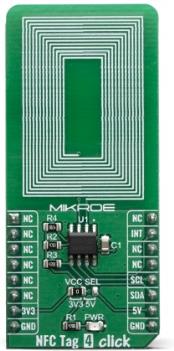
|
|
NFC Tag 4 Click is NFC tag device, offering 16 Kbit of electrically erasable programmable memory (EEPROM). This Click Board™ offer two communication interfaces. The first one is an I2C serial link and can be operated from a DC power supply. The second one is a RF link activated when Click Board™ act as a contactless memory powered by the received carrier electromagnetic wave. It is perfectly suited for using in wide variety of applications, such as NFC enabled business cards, stickers, wristbands, key fobs, pens, movie passes, hang tags, medication bottles, and many more.
NFC Tag 4 click is supported by a mikroSDK compliant library, which includes functions that simplify software development. This Click board™ comes as a fully tested product, ready to be used on a system equipped with the mikroBUS™ socket.
|
|
|
|
 |
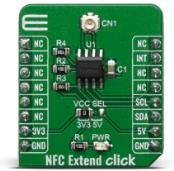
|
|
NFC Extend Click is NFC tag interface device with possibility of using any shape and size external antenna, offering 16 Kbit of electrically erasable programmable memory (EEPROM). This Click Board™ offer two communication interfaces. The first one is an I2C serial link and can be operated from a DC power supply. The second one is a RF link activated when Click Board™ act as a contactless memory powered by the received carrier electromagnetic wave. It is perfectly suited for using in wide variety of applications, such as NFC enabled business cards, stickers, wristbands, key fobs, pens, movie passes, hang tags, medication bottles, and many more.
NFC Extend Click board™ is supported by a mikroSDK compliant library, which includes functions that simplify software development. This Click board™ comes as a fully tested product, ready to be used on a system equipped with the mikroBUS™ socket.
For any functionality NFC Extend click have to be used with one of NFC antenna.
|
|
|
|
 |

|
|
CapSense click features the CY8C201A0 capacitive sensing module, which takes human body capacitance as an input and directly provides real time sensor information output via I2C. The board contains capacitive sensing elements (5-segment slider and two buttons) as well as two LEDs. The CY8C201A0 capacitive controller has high immunity against radiated and conductive noise. The board can operate at either 3.3V or 5V, with selection by means of SMD jumper. |
|
|
|
 |
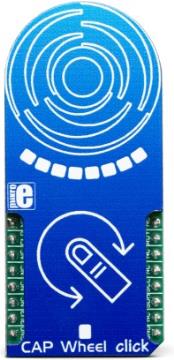
|
|
CAP Wheel Click is a capacitive touch sensor with round shaped electrodes integrated on a Click board™. This click can sense touch even through plastic, wood, or other dielectric materials, which can be used to protect the surface of the PCB and the sensor pad trace itself. Therefore, this Click board™ comes with overlay, made of plexiglass. Unlike the mechanical button, the capacitive touch button lasts much longer, it is not prone to damage and wear over time and it is very reliable.
Cap Wheel click is supported by a mikroSDK compliant library, which includes functions that simplify software development. This Click board™ comes as a fully tested product, ready to be used on a system equipped with the mikroBUS™ socket.
|
|
|
|
 |

|
|
CAP Wheel 2 Click is a capacitive touch sensor with round-shaped electrodes integrated on a Click board™. This click can sense touch even through plastic, wood, or other dielectric materials, which can be used to protect the surface of the PCB and the sensor pad trace itself. Therefore, this Click board™ comes with overlay, made of plexiglass. Unlike the mechanical button, the capacitive touch button lasts much longer, it is not prone to damage and wear over time and it is very reliable. This Click board feature QS263B sensor which contains a ProxSense® module that uses patented technology to provide detection of proximity and touch conditions on numerous sensing lines.
Cap Wheel 2 click is supported by a mikroSDK compliant library, which includes functions that simplify software development. This Click board™ comes as a fully tested product, ready to be used on a system equipped with the mikroBUS™ socket.
|
|
|
|
 |
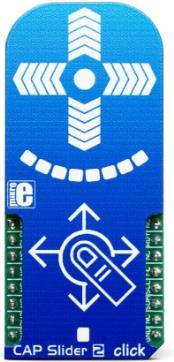
|
|
CAP Slider 2 Click is a capacitive touch sensor with XY cross shaped electrodes integrated on a Click board™. This click can sense touch even through plastic, wood, or other dielectric materials, which can be used to protect the surface of the PCB and the sensor pad trace itself. Therefore, this Click board™ comes with overlay, made of plexiglass. Unlike the mechanical button, the capacitive touch button lasts much longer, it is not prone to damage and wear over time and it is very reliable.
This Click board feature QS333 sensor which contains a ProxSense® module that uses patented technology to provide detection of proximity and touch conditions on numerous sensing lines.
Cap Slider 2 click is supported by a mikroSDK compliant library, which includes functions that simplify software development. This Click board™ comes as a fully tested product, ready to be used on a system equipped with the mikroBUS™ socket.
|
|
|
|
 |
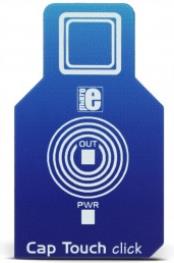
|
|
Cap Touch click is a capacitive touch sensing button, integrated on a click board™. It can be activated by touch. This click can sense touch even through plastic, wood, or other dielectric materials, which can be used to protect the surface of the PCB and the sensor pad trace itself. Unlike the mechanical button, the capacitive touch button lasts much longer, it is not prone to damage and wear over time and it is very reliable.
Capacitive buttons are a very popular method of powering up various devices. Besides the aforementioned benefits, having a touch sensitive button on a device allows for a compact design, opens possibilities for various kinds of human-machine interface and - it looks good and modern, especially if accompanied by a LED that turns on when activated, just like the one on Cap Touch click. Cap Touch click can find its place among many applications - for touch activated lighting controls, touch activated control panels, toys and any other applications that need a switch or a button. |
|
|
|
 |
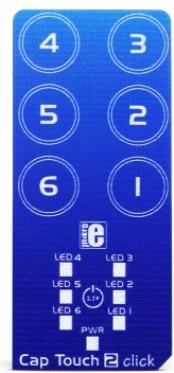
|
|
Cap Touch 2 click is a capacitive touch sensing Click board™, with the advanced touch/proximity sensor IC, based on the proprietary RightSense® technology from Microchip. Cap Touch 2 click has six touch sensitive channels and six independent LED drivers with several operating modes, including touch sensor linking, as well as the pulsing and breathing effects. It also supports Multiple Touch Pattern Detection (MTPD), and press-and-hold function. Capacitive touch sensor inputs are protected from false detections, which can be caused by the low noise and RF interferences, providing a very reliable touch sensing functionality. |
|
|
|
 |
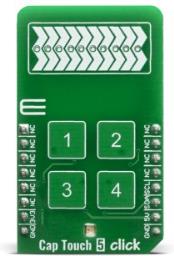
|
|
Cap Touch 5 Click is a capacitive touch sensing Click board™ which features the CY8CMBR3106S-LQXI CapSense® Express™ controller which enables advanced, yet easy-to-implement, capacitive touch sensing user interface solutions. It supports up to 16 capacitive sensing inputs, eliminates time-consuming firmware development. This controller is ideal for implementing capacitive buttons, sliders, and proximity sensing solutions with minimal development-cycle times.
Cap Touch 5 Click is supported by a mikroSDK compliant library, which includes functions that simplify software development. This Click board™ comes as a fully tested product, ready to be used on a system equipped with the mikroBUS™ socket.
|
|
|
|
 |

|
|
Touchkey click has four capacitive pads powered by TTP224, a touchpad detector IC. Capacitive buttons like these can be toggled even when placed under a layer of glass or paper.
|
|
|
|
 |
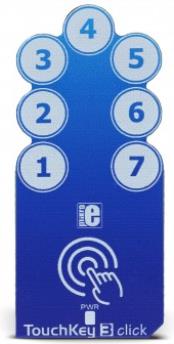
|
|
TouchKey 3 click is equipped with advanced capacitive sensors, based on the proprietary QTouch® technology, that can be used to sense touch on 7 different keys. Besides quite a large number of QTouch® capacitive sensing channels, it also offers some additional advanced features, such as the Adjacent Key Suppression (AKS®), a technology that ensures correct button press, even when the touch sensing pads are placed close to each other.
With its many sensing channels and their advanced sensing technologies, TouchKey 3 really stands out from the crowd. It can be used as a multi-button control pad for various embedded applications, replacing mechanical buttons, which are typically prone to malfunctions, with elegant and durable touch sensing pads. Since it can detect touch through 5mm thick layer of plastic, TouchKey 3 is covered with a protective plastic coating, which makes the click board™ even more robust and wear-proof. |
|
|
|
 |
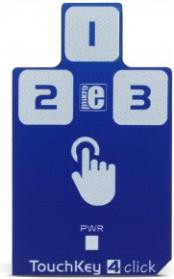
|
|
Touch Key 4 click is a capacitive touch sensing Click board™, with the advanced touch/proximity sensor IC. It has three independently configurable channels and can work in several operating modes, including multiple button pattern detection mode, combo mode, press and hold detection mode, power button mode, and more. Capacitive touch sensor inputs are protected from false detection, which can be caused by the noise and RF interferences, providing a very reliable touch sensing functionality. Electrostatic Discharge (ESD) protection up to 8kV ensures that no ESD failures will ever occur while interacting with the sensor surface. |
|
|
|
 |

|
|
Touchpad click is a capacitive touch input device driven by Microchip's low-powered MTCH6102 controller. The touchpad surface is covered with a sheet of black plastic to demonstrate the chip's support for cover layers (up to 3mm for plastic, 5mm for glass) Touchpad click communicates with the target MCU through the mikroBUS I2C interface (SCL and SDA pins), with additional functionality provided by the Interrupt and RSTL pins. Designed to use a 3.3V power supply. |
|
|
|
 |
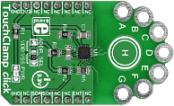
|
|
TouchClamp click is a mikroBUS add-on board with NXP's MPR121 proximity capacitive touch sensor controller. It has seven plated holes for clamps which can be used to connect any - literally any - conductive object in order to use it as an input button to send an interrupt to the target board MCU. It's great for creating installations where users interact with the environment in unexpected ways. There's also an extra capacitive button in the middle. TouchClamp click communicates with the target MCU through the mikroBUS INT pin and I2C interface (SCL, SDA). The board has an onboard ADDR. SEL. jumper for choosing I2C addresses. Designed to use a 3.3V power supply only. |
|
|
|
 |

|
|
Cap Extend click is a mikroBUS add-on board with a SEMTECH SX8633 low power, capacitive button touch controller. It has 12 pins for connecting capacitive inputs (either touch-buttons or proximity sensors). Any sort of conductive object can be used as an input. Additional 8 GPIO pins, available on the side-edges of the board, can be used as LED drivers. The SX8633 IC integrates a 10 bit ADC - a resolution high enough to support a wide variety of touch pad sizes and shapes to be used with the click. Cap Extend click communicates with the target MCU through the mikroBUS I2C interface, with additional functionality provided by RST and INT pins. Designed to use a 3.3V power supply only. |
|
|
|
 |
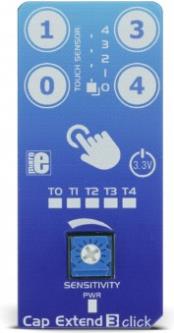
|
|
Cap Extend 3 click features four capacitive sensor pads integrated on the PCB, that can sense touch through a variety of different materials. This click can sense touch through plastic, wood, or even metal, thanks to the proprietary Metal over Capacitive technology. All these materials can be used to protect the surface of the PCB and sensor pad traces, allowing implementation of all kinds of human-machine interfaces and seamless integration of the touch-sensitive buttons into various kinds of front panels. The click also features a connector used for connecting to external sensors.
Features like the multi-stage active noise suppression filtering, automatic environmental compensation, high signal-to-noise ratio (SNR) and support for a wide range of sensor pad shapes and sizes, allow this device to be used as a reliable replacement for buttons or switches in many applications, including light switches, office equipment and toys, display and keypad backlight activation, and similar applications where a reliable and aesthetically pleasing button alternative is required. |
|
|
|
 |
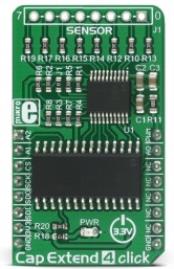
|
|
Cap Extend 4 click provides a unique opportunity to control digital devices by using a variety of physical objects. This click adds touch/proximity detection feature to any application, providing an easy and intuitive framework for building a human-machine interface. The click can be connected to eight different sensors, which can sense touch/proximity through a number of various materials, such as wood, plastic or even metal, thanks to Microchip's proprietary Metal over Capacitive technology.
Cap Extend 4 click can be used for building human-machine interfaces for various touch activated applications, such as light switches, toys and office equipment, device activation via the PCB touch buttons, and other innovative and interesting ways of touch control. |
|
|
|
 |
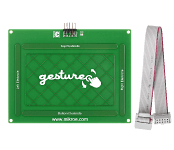
|
|
The Gesture Board, carrying Microchip's MGSC3130 3D gesture recognition controller, brings a new approach to designing intuitive user interfaces. It's like a touchpad whose input area extends 10cm upwards into space. Users will be able to command an MCU or PC by gesturing with hands and fingers above the board, and by touching and tapping its surface. The board comes with an IDC cable connector. The silkscreen on the back of the board depicts various supported gestures (flicking, drawing circles, airwheels, taps and double taps and so on). The Gesture Board communicates over an I2C interface. For use with with a PC, a special I2C to USB adapter board is available (see 'Accessories'). |
|
|
|
 |
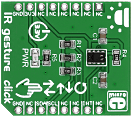
|
|
IR Gesture click is a mikroBUS add-on board that enables contactless gesture recognition, along with ambient light and proximity sensing capabilities with the APDS-9960 IC. This sensor integrates an LED and four directional photodiodes that receive the reflecting light. An internal gesture engine deduces the velocity, direction and distance of nearby objects (while cancelling the ambient light). You can implement a variety of gestures, from from basic directional swipes (up, down, left or right) to more complex combinations. Since the chip can work as a proximity sensor, the gesture engine can be configured to wake up automatically when a user's hand approaches. The board communicates with the target board MCU through the mikroBUS I2C interface, with an additional hardware inerrupt pin (INT). IR Gesture click uses a 3.3V power supply. |
|
|
|
 |
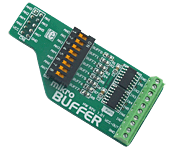
|
|
The mikroBuffer Board features two MCP6284 operational amplifiers which provide a total of 8 inputs and which are specifically designed for low-cost, low-power and general-purpose applications. Low power supply voltage, low quiescent current and wide bandwidth make this board ideal for battery-powered applications. The board features an IDC10 female header which is compatible with mikroElektronika development boards, and DIP switchws for selecting input lines. |
|
|
|
 |
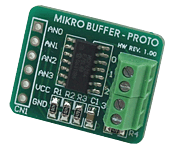
|
|
The mikroBuffer Board features the MCP6284 operational amplifier with a total of 4 inputs and which is specifically designed for low-cost, low-power and general-purpose applications. Low power supply voltage, low quiescent current and wide bandwidth make this board ideal for battery-powered applications. |
|
|
|
 |

|
|
DALI Click is a compact board that enables you to add Digital Addressable Lighting Interface (DALI) to your design. The board features two optocouplers, a push button and screw terminals. DALI Click communicates with the target board via four mikroBUS lines (RST, CS, PWM and INT). Data between MCU and devices is transferred over two-wire differential bus by means of an asynchronous, half-duplex, serial protocol. It is possible to address up to 64 devices in a DALI stand alone systems and more than 64 devices as DALI subsystems (gateways). The board is designed to use a 3.3V or 5V power supply, and has an LED diode to indicate the presence of power. |
|
|
|
 |
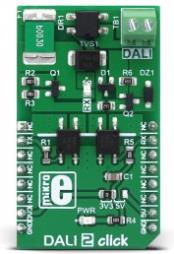
|
|
DALI is an international standardized protocol for intelligent digital lighting control, that enables an easy implementation of robust, scalable and flexible lighting networks. DALI stands for Digital Addressable Lighting Interface and it was first introduced in the late ‘90s. Since then, it has undergone a number of revisions. The most recent version of the DALI standard IEC 62386, is also known as DALI-2, which brings many new features to the existing DALI protocol.
The simplest DALI network consists of a controller and one or more slave devices, such as LED drivers, dimmers, and ballasts, equipped with DALI interfaces. DALI 2 click can be used to develop applications for controlling other slave nodes of the DALI network or to develop slave node applications that would respond to the commands sent by the master control unit. DALI 2 click offers a simple and reliable interface to DALI and DALI 2 communication bus, making it possible to dive into the world of intelligent lighting. |
|
|
|
 |
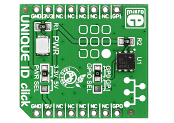
|
|
Unique ID click carries DS2401, an enhanced silicon serial number IC. It's a low cost solution for providing a unique registration number to your design. The chip consists of a factory-lasered 64-bit ROM that includes a uniques a 48-bit serial number, an 8-bit CRC, and an 8-bit family code. It uses 1-wire communications for interfacing with the target board microcontroller, either through a GP1 or GP0 pin (here in place of the default AN and PWM mikroBUS pins). The board is designed to use either a 3.3V or 5V power supply. |
|
|
|
 |
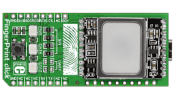
|
|
Fingerprint click is a click board solution for adding biometric security to your design. It carries the GTS-511E2 module, which is the thinnest optical touch fingerprint sensor in the world. The module comprises a CMOS image sensor with a special lens and covering that records real fingerprints while resisting 2D fakes. The click board also carries an STM32 MCU for processing the images and forwarding them to an external MCU or PC. We created a Windows application that provides an easy interface for communicating with Fingerprint click. The board is designed to use a 3.3V power supply. |
|
|
|
 |
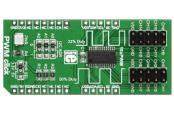
|
|
PWM click is a simple solution for controlling 16 PWM outputs through a single I2C interface. You can use it to control anything from a simple LED strip to a complex robot with a multitude of moving parts. The click board carries the PCA9685PW IC. The board has an additional set of pins that allow you to connect up to seven PWM clicks together (using three jumpers to specify a different I2C address for each one). This will allow you to get a total of 112 pwm outputs on a single I2C line. PWM click is designed to use either a 3.3V or 5V power supply. |
|
|
|
 |
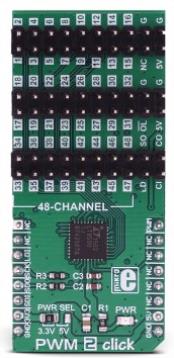
|
|
PWM 2 click offers 48 independently controlled PWM channels, available over the onboard headers, perfectly suited for driving LEDs. Each channel has a 12-bit PWM register associated to it, with the addition of the 6-bit correction register, also known as the dot correction register. PWM 2 is able to detect both synchronization errors and open LED errors, signaling the error via the dedicated pin and the status frame. The Click board™ fully supports cascading, exposing all the necessary pins on the onboard headers, so it can support a large array of LED elements. |
|
|
|
 |

|
|
RF Meter click is a radio frequency power measurement device covering a frequency span from 1 MHz to 8 GHz over a 60 dB range (approximately). It enables monitoring and measuring frequency levels to ensure proper functioning and leak detection. An external antenna acquires the signal, which is then processed by the AD8318 logarithmic detector. The resulting voltage is fed into an MCP3201 ADC. For communicating with the target board MCU, the mikroBUS SPI interface is used (CS, SCK, MISO pins), with additional TEMP OUT pin. |
|
|
|
 |

|
|
NFC USB Dongle is an NFC Reader-Writer based on NXP's PN7150 high-performance full NFC controller, supporting all NFC Forum modes. The USB NFC Dongle is powered through USB connector.
This NFC controller supports all NFC Forum communication modes like peer to peer, reader/writer and Host Card Emulation. It allows interacting with all NFC devices on the market according to NFC Forum: from simple NFC tags to NFC-enabled smartphone. |
|
|
|
 |
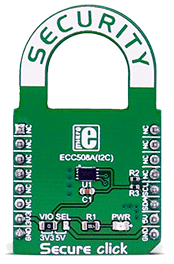
|
|
Secure click carries the ATECC508A cryptographic coprocessor with secure hardware-based key storage. The click is designed to run on either 3.3V or 5V power supply. It communicates with the target microcontroller over I2C interface. |
|
|
|
 |
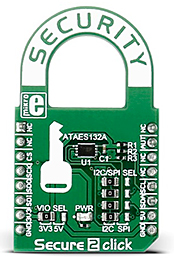
|
|
Secure 2 click carries the ATAES132A, a cryptographic coprocessor with secure hardware-based key storage from Microchip. The click is designed to run on either 3.3V or 5V power supply. Secure 2 click communicates with the target microcontroller over SPI and I2C interface, with additional functionality provided by the INT pin on the mikroBUS™ line. |
|
|
|
 |
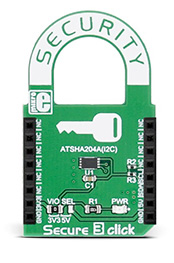
|
|
Secure 3 click carries the ATSHA204A, a cryptographic coprocessor with secure hardware-based key storage from Microchip. The click is designed to run on either 3.3V or 5V power supply. Secure 3 click communicates with the target microcontroller over an I2C interface.
NOTE: The click comes with stacking headers which allow you to combine it with other clicks more easily by using just one mikroBUS™ socket. |
|
|
|
 |
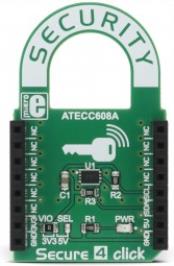
|
|
Secure 4 click includes the ATECC608A, a secure CryptoAuthentication™ device from Microchip, which is equipped with an EEPROM array which can be used for storing of up to 16 keys, certificates, consumption logging, security configurations and other types of secure data. Access to the various sections of memory can be restricted in several different ways and then the configuration can be locked permanently, to prevent changes.
The ATECC608A equipped on this click board™, supports the I2C interface with a flexible command set, that allows use in various security applications, including Network/IoT Node Endpoint Security, Secure Boot, Small Message Encryption, Key Generation for Software Download, Ecosystem control, Anti Counterfeiting and similar.
NOTE: The click board™ comes with stacking headers which allow you to combine it with other click boards™ more easily by using just one mikroBUS™ socket. |
|
|
|
 |
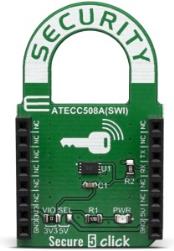
|
|
Secure 5 Click includes the ATECC508A, a secure CryptoAuthentication™ device from Microchip, which is equipped with an EEPROM array which can be used for storing of up to 16 keys, certificates, consumption logging, security configurations and other types of secure data. The ATECC508A equipped on this click board™, supports the SWI interface with a flexible command set, that allows use in various security applications, including Network/IoT Node Endpoint Security, Secure Boot, Small Message Encryption, Key Generation for Software Download, Ecosystem control, Anti Counterfeiting and similar.
Secure 5 click board™ is supported by a mikroSDK compliant library, which includes functions that simplify software development. This Click board™ comes as a fully tested product, ready to be used on a system equipped with the mikroBUS™ socket.
The click board™ comes with stacking headers which allow you to combine it with other click boards™ more easily by using just one mikroBUS™ socket.
|
|
|
|
 |
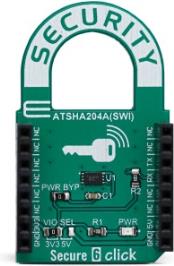
|
|
Secure 6 Click includes the ATSHA204A, a secure CryptoAuthentication™ device from Microchip, which is equipped with an EEPROM array which can be used for storing of up to 16 keys, certificates, consumption logging, security configurations and other types of secure data. The ATSHA204A equipped on this click board™, supports the SWI interface with a flexible command set, that allows use in various security applications, including Network/IoT Node Endpoint Security, Secure Boot, Small Message Encryption, Key Generation for Software Download, Ecosystem control, Anti Counterfeiting and similar.
Secure 6 click board™ is supported by a mikroSDK compliant library, which includes functions that simplify software development. This Click board™ comes as a fully tested product, ready to be used on a system equipped with the mikroBUS™ socket.
NOTE: The click board™ comes with stacking headers which allow you to combine it with other click boards™ more easily by using just one mikroBUS™ socket.
|
|
|
|
 |
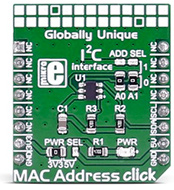
|
|
MAC Address click provides a unique node address for your application. It also has 1Kbit of writable EEPROM memory. MAC Address click carries the 24AA025E64 2K I2C Serial EEPROM with EUI-64™ node identity. The click is designed to run on either 3.3V or 5V power supply. MAC Address click communicates with the target microcontroller over I2C interface. |
|
|
|
 |
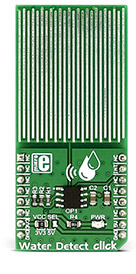
|
|
Avoid plumbing and water leakage disasters
Water Detect click is used for detecting water and other electroconductive liquids. If the detection area is wet the output of Microchip's MCP606 CMOS op-amp will go positive, signaling the presence of liquid.
Water Detect click can be used as a household flood alarm sensor, rain detector for smart buildings or for water tanks that act as a limit switch for a pump. |
|
|
|
 |
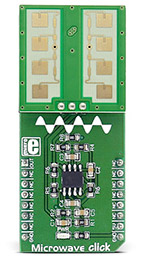
|
|
Microwave click detects movement, thanks to the PD-V11 a 24GHz microwave motion sensor. The typical use for Microwave click is a proximity or motion detector in various applications and devices.
The Microwave click can detect movement or proximity by using the Doppler effect. The onboard microwave motions sensor transmits waves, and picks them back as they hit an object, with their frequency changed.
Microwave click does not need optical visibility to work, and the waves can penetrate many kinds of barriers and obstacles. |
|
|
|
 |
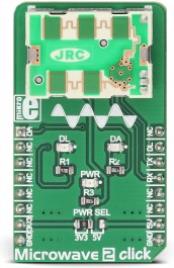
|
|
Microwave 2 click is an accurate and reliable short to medium range motion detection Click board™, based on a Doppler radar principle. Thanks to the highly integrated NJR4265RF2C1, an intelligent 24GHz microwave motion sensor, it can accurately sense the movement of a low-speed object. Featuring an integrated RF circuit, IF amplifier, and the MCU with its accompanying circuitry, it is able to provide signal processing, allowing better isolation of the useful movement signal and reduction of the background noise. In addition, it can detect an object approaching or leaving away, and autonomously signalize the detected event.
Note: Microwave 2 click board is available for all of EU regions. |
|
|
|
 |
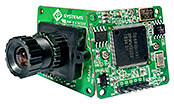
|
|
MicroCAM 3 (uCAM-III)
The uCAM-III (microCAM-III) is a highly integrated serial camera module which can be attached to any host system that requires a video camera or a JPEG compressed still camera for embedded imaging applications, and is the new upgrade to the popular uCAM-II, which is backwards compatible but includes some additional features. |
|
|
|
 |
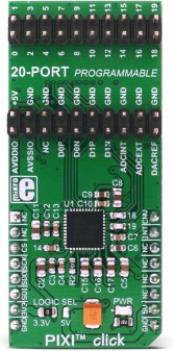
|
|
PIXI™ click is equipped with MAX11300 IC from Maxim Integrated, which features Maxim Integrated's versatile, proprietary PIXI™ technology - it is the industry's first configurable 20-channel mixed-signal data converter. Besides the 12bit multichannel SAR ADC and buffered DAC, it also features one internal and two external temperature sensors for tracking the junction and the environmental temperatures. Adjacent pairs of ports can be configured as logic-level translators for open-drain devices or analog switches. Each port is individually configurable with up to four selectable voltage ranges within -10 V to +10 V.
PIXI™ ports provide highly flexible hardware configuration for 12-bit mixed-signal applications. The MAX11300 is best suited for applications that demand a mixture of several analog and digital functions, such as monitoring and adjusting the bias on the power amplifiers, digital level shifters, automatic fan speed controllers, etc. Actually, it can easily adapt to specific application requirements, allowing for an easy reconfiguration, which makes it usable in virtually any embedded application. |
|
|
|
 |
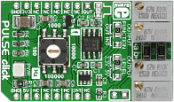
|
|
PULSE click is a pulse generator with an adjustable frequency. It carries the NE555 precision timer capable of producing highly accurate time delays. The frequency of PULSE click is configured in two steps. First select between four frequency bands by using the frequency selector - a circular central switch in the middle of the board. Starting from the six-o-clock position and moving counter-clockwise in quarters, it has 4 options: 0) Up to 100 Hz; 1) Up to 1 kHz; 2) Up to 10 kHz; and 3) Up to 100 kHz. After you select the appropriate position, use the onboard potentiometer to fine-tune the desired output frequency. The resulting output can be configured either as a digital output (communicating with the MCU through the mikroBUS OUT pin) or an interrupt (INT pin). The board is designed to use either a 3.3V or a 5V power supply. |
|
|
|
 |
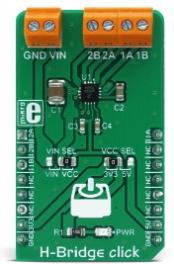
|
|
H-Bridge click is a high-efficiency dual H-bridge driver Click board™, capable of providing reasonably high current while driving the connected load with up to 7V. Since the used driver IC has two full H-bridge channels, this Click board™ is an ideal solution for driving smaller bipolar stepper motors. H-Bridge click provides driving in both directions, with an addition of the brake mode, and the high impedance mode (Hi-Z). Overshoot current suppression algorithm protects the output stages from being damaged if both high-side and low-side MOSFETs on a single H-bridge channel become conductive. |
|
|
|
 |
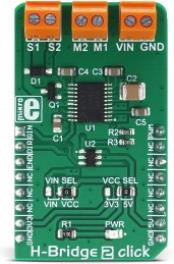
|
|
H-Bridge 2 click can be used to drive a motor by utilizing a specific configuration of the output stage MOSFETs, known as the H-bridge. This configuration enables H-Bridge 2 click to drive a motor with up to 1.2A and 15V, providing control of the speed and direction, as well as the dynamic (rheostatic) braking capability. The Click board™ uses a monolithic H-bridge IC, which implements a set of features that provide trouble-free operation of the connected motor, such as the undervoltage detection, shoot-through current protection, efficient output stage MOSFETs with low RDSON, level shifted output for an external MOSFET control and more. |
|
|
|
 |

|
|
H-Bridge 3 Click is designed for the control of small DC motors and inductive loads, it features TLE9201SG a general purpose 6A H-Bridge perfectly suited for industrial and automotive applications. This IC meets the harsh automotive environmental conditions and it is qualified in accordance with the AEC-Q100 standard, also has set of features such as the short circuit and over-temperature protection, under-voltage protection, detailed SPI diagnosis or simple error flag and fully 3.3/5.5V compatible logic inputs.
H-bridge 3 click is supported by a mikroSDK compliant library, which includes functions that simplify software development. This Click board™ comes as a fully tested product, ready to be used on a system equipped with the mikroBUS™ socket.
|
|
|
|
 |
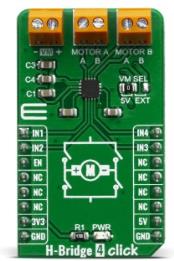
|
|
H-Bridge 4 Click is a Click board™ that contains the AP1010AEN, which is a two channel H-Bridge motor driver compatible with a motor operating voltage up to 18V and can drive two DC motors or one stepper motor. The protection circuit has under voltage lockout circuit, thermal shutdown circuit, and overcurrent protection circuit, and overcurrent protection circuit can be disabled with the DIS OCP terminal.
H-Bridge 4 click supports multiple connection options and can be used in different application setups which might include DC or Stepper motors.
|
|
|
|
 |
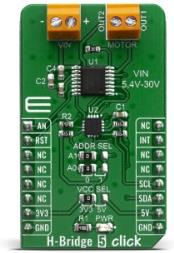
|
|
The H-Bridge 5 Click is designed for control DC motors and inductiv loads. This Click board™ contains the MP6515GF-Z, a H-bridge motor driver from MPS, It features an Full H-Bridge driver with Internal safety features include over-current protection, input over-voltage protection, under voltage lockout (UVLO), and thermal shutdown. This click also contains the PCA9538A, a low-voltage 8-bit General Purpose Input/Output (GPIO) expander. The H-Bridge 5 click can be used for Solenoid Drivers and DC Brush Motor Drive.
The H-Bridge 5 click is supported by a mikroSDK compliant library, which includes functions that simplify software development. This Click board™ comes as a fully tested product, ready to be used on a system equipped with the mikroBUS™ socket.
|
|
|
|
 |

|
|
iButton click - is an iButton™ probe Click board™. The iButton is a technology based on the one-wire communication protocol, and a chip usually packed in a robust stainless steel casing. The button-shaped iButton device has two contacts - the lid and the base. These contacts carry the necessary connections down to a sensitive silicone chip, embedded inside the metal button. When the iButton touches the reader probe on the Click board™, it establishes the communication with the host MCU, via the one-wire interface. The communication is almost instant, so it is enough to press the iButton lightly to the probe contacts.
Note: The Click board™ comes with the DS1990A, a serial number iButton™ device with a unique 64-bit serial number. For more information on the serial number iButton™ device, please visit the official product page. |
|
|
|
 |
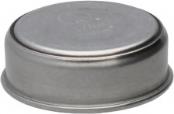
|
|
DS1990A is a unique serial number identification iButton™. The iButton is a technology based on the one-wire communication protocol, and a chip packed in a robust stainless steel casing. This button shaped device has two contacts - the lid and the base. These contacts carry the necessary connections down to a sensitive silicone chip, embedded inside the metal button. When the iButton touches the reader probe on the Click board™, it establishes the communication with the host MCU, via the one-wire interface. The communication is almost instant, so it is enough to press the iButton lightly to the probe contacts. |
|
|
|
 |
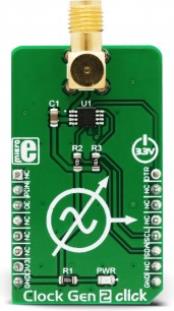
|
|
Clock Gen 2 click is an accurate square wave generator that can generate a clock signal in the range from 260kHz to 66.6MHz. It generates a square wave in the frequency of 66.6MHz, which is then processed by the prescaler, which can be set in the range from 2 0 up to 2 8. This allows the full frequency range to be achieved on the output. The DS1087L, a 3.3V spread-spectrum EconOscillator, used on the Clock Gen 2 click, offers the spread-spectrum function, which can be controlled via the IC pin and register setting. This allows reduced EMI, especially on the high frequencies. Finally, the DS1087L offers a NV memory (EEPROM), which is used for storing the values of the configuration registers. |
|
|
|
 |
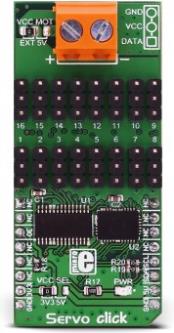
|
|
Servo click is a 16-channel PWM servo driver with the voltage sensing circuitry. It can be used to simultaneously control 16 servo motors, each with its own programmable PWM signal. The frequency of the control PWM signal can be programmed in the range from 24 Hz to 1526 Hz, which is an ideal range for driving various types of servos. An accurate 16bit A/D converter is used to sample the voltage drop across the shunt resistor on each of the 16 channels, giving feedback on the servo current consumption. This way, Servo click is able to provide an information about the servo operation parameters, with no additional modifications of the servo itself. |
|
|
|
 |
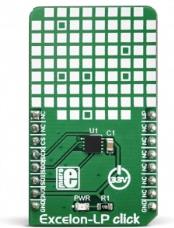
|
|
Excelon LP click carries a ferroelectric RAM module. Ferroelectric RAM, also known as FRAM, is a non-volatile memory type, with characteristics comparable to much faster DRAM memory modules. It is a much faster alternative to common serial FLASH and EEPROM modules which use the conventional technologies. Excelon LP click is ideal for embedded applications which frequently execute write operations. It can be used for a wide range of applications, ranging from data collection where the number of write cycles may be critical, to demanding industrial controls where lengthy write intervals of conventional serial FLASH or EEPROM memory modules can cause data loss.
It comes in the package which also includes the mikroSDK™ software and a library with all the functions. The Click board™ comes as a fully tested and approved prototype, making it a reliable device ready to use on the development board. |
|
|
|
 |
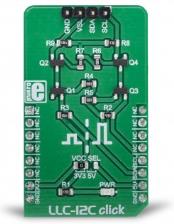
|
|
LLC I2C click can be utilized as the level converter for logic signals, which makes it a very useful Click board™. The topology of this logic level conversion (LLC) circuit is perfectly suited for the bi-directional I2C communication. Although there are some specialized integrated circuits on the market, sometimes it is more convenient to have a simple solution made of just a few passive elements and four MOSFETs. Besides this, MOSFETs can withstand up to 20V across their terminals (12V VGS), and they support far greater currents than typical ICs, making them less likely to fail. The LLC circuitry, also known as the level translator or level shifter, can be used in virtually any application that utilizes the I2C communication protocol and needs matching between the logic voltage levels.
It comes in the package which also includes the mikroSDK™ software and a library with all the functions. The Click board™ comes as a fully tested and approved prototype, making it a reliable device ready to use on the development board.
|
|
|
|
 |

|
|
The LLC SPI click is a very useful Click board™ which can be utilized as the level converter for logic signals. The topology of this logic level conversion (LLC) circuit is perfectly suited for SPI communication between devices with unmatched voltages of their logic signals. Although there are some specialized integrated circuits on the market, sometimes it is more convenient to have a simple solution made of just a few passive elements and four MOSFETs.
It comes in the package which also includes the mikroSDK™ software and a library with all the functions. The Click board™ comes as a fully tested and approved prototype, making it a reliable device ready to use on the development board.
|
|
|
|
 |
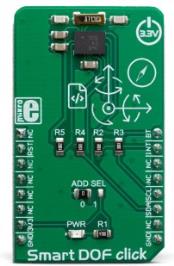
|
|
SmartDOF click features a highly advanced integrated system-in-package (SiP) solution with three different sensors on-chip: triaxial accelerometer, magnetometer, and triaxial gyroscope are all integrated on the same die, along with the powerful 32-bit ARM® Cortex®-M0+ MCU. Thanks to the integrated MCU, the BN080 SiP provides extensive signal processing. This allows many features to be implemented, including the MotionEngine™ support. The MotionEngine™ software allows extensive data modes and events detection. The BNO080 also supports the dynamic calibration of the sensors for temperature and aging, offering ultimate accuracy and reliability.
SmartDOF click is supported by a mikroSDK compliant library, which includes functions that simplify software development. This Click board™ comes as a fully tested product, ready to be used on a system equipped with the mikroBUS™ socket.
|
|
|
|
 |
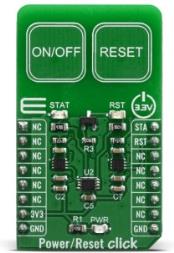
|
|
Power/Reset Click is equipped with two capacitive touch pads on a single click board™. It can be activated by touch, and unlike the mechanical button, the capacitive touch button lasts much longer, it is not prone to damage and wear over time and it is very reliable. Capacitive buttons are a very popular method of powering up or resetting various devices. Besides the aforementioned benefits, having a touch sensitive button on a device allows for a compact design, opens possibilities for various kinds of human-machine interface and - it looks good and modern, especially if accompanied by a LED that turns on when activated, just like the one on Power/Reset Click. This click board™ can find its place among many applications - for touch activated lighting controls, touch activated control panels, toys and any other applications that need a switch or a button for powering and resetting a device.
Power/Reset click board™ is supported by a mikroSDK compliant library, which includes functions that simplify software development. This Click board™ comes as a fully tested product, ready to be used on a system equipped with the mikroBUS™ socket.
|
|
|
|
 |
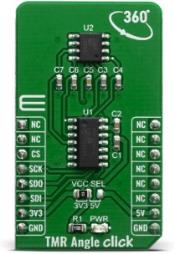
|
|
TMR Angle Click is a Click board™ perfectly suited for developing applications that range from steering angle applications with the highest functional safety requirements to motors for wipers, pumps and actuators and electric motors in general. This is thanks to the TLE5501, which is dedicated to any automotive but also industrial and consumer applications like robotics or gimbal.
The TMR Angle click is supported by a mikroSDK compliant library, which includes functions that simplify software development. This Click board™ comes as a fully tested product, ready to be used on a system equipped with the mikroBUS™ socket.
|
|
|
|
 |
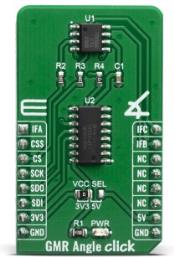
|
|
The GMR Angle Click is a Click board™ that features the TLI5012B E1000, which is a pre-calibrated 360° angle sensor that detects the orientation of a magnetic field, made by Infineon. The GMR Angle click is ideal for angular position sensing in industrial and consumer applications such as electrical commutated motor (e.g. BLDC), fans or pumps.
The GMR Angle click is supported by a mikroSDK compliant library, which includes functions that simplify software development. This Click board™ comes as a fully tested product, ready to be used on a system equipped with the mikroBUS™ socket.
|
|
|
|
 |
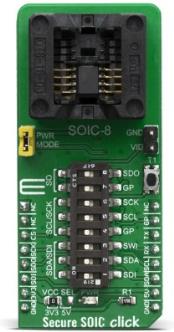
|
|
Secure SOIC Click is universal, socket based click board, specifically designed for the Microchip CryptoAuthentication™ devices in an 8-pin SOIC package. This click board™ supports the SPI, I2C, and the SWI interface based ICs from the CryptoAuthentication™ family with a flexible command set, that allows use in various security applications, including Network/IoT Node Endpoint Security, Secure Boot, Small Message Encryption, Key Generation for Software Download, Ecosystem control, Anti Counterfeiting and similar.
Secure SOIC click is supported by a mikroSDK compliant library, which includes functions that simplify software development. This Click board™ comes as a fully tested product, ready to be used on a system equipped with the mikroBUS™ socket.
Secure SOIC click comes with 3 ICs ATSHA204A included in the package.
|
|
|
|
 |
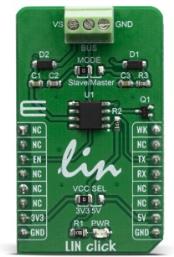
|
|
The LIN Click is a Click board™ that features the TLE7259-3GE, a LIN transceiver from Infineon Technologies, with integrated wake-up and protection features. The combination of Slave and Master node in LIN systems, the LIN click can be used for automotive applications: body controllers and gateway modules, switch panels, wiper or window lift modules, door and seat control modules and engine management units.
The LIN click is supported by a mikroSDK compliant library, which includes functions that simplify software development. This Click board™ comes as a fully tested product, ready to be used on a system equipped with the mikroBUS™ socket.
|
|
|
|
 |
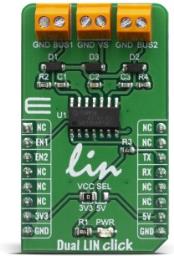
|
|
The Dual LIN click is a Click board™ based on the TLE7268SKXUMA1, a Dual LIN transceiver from Infineon. Given the features included in this transceiver, the Dual LIN transceiver designed for data transmission rates up to 20 kbps being fully compliant to the ISO17987-4, LIN specification 2.2A and SAE J2602 standards.
The Dual LIN click is supported by a mikroSDK compliant library, which includes functions that simplify software development. This Click board™ comes as a fully tested product, ready to be used on a system equipped with the mikroBUS™ socket.
|
|
|
|
 |

|
|
GSR click bundle - measure the electrical activity of muscles.
|
|
|
|
 |

|
|
AD-SDIO 2 Click is a quad-channel software configurable input/output solution based on AD74413R, for building and process control application. The AD74413R is a quad-channel software configurable input/output solution for building and process control applications. The device provides a fully integrated single chip solution for input and output operation. The AD-SDIO 2 click contains four 13-bit DACs, one per chanal, and 16-bit S-? ADC. These options give a lot of flexibility in choosing functionality for analog output, analog input, digital input, resistance temperature detector (RTD), and thermocouple measurements integrated into a single chip solution with a serial peripheral interface (SPI).
The AD-SDIO 2 click is supported by a mikroSDK compliant library, which includes functions that simplify software development. This Click board™ comes as a fully tested product, ready to be used on a system equipped with the mikroBUS™ socket.
|
|
|
|
 |
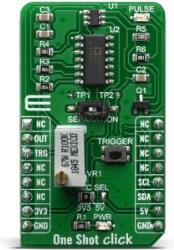
|
|
One Shot Click is equipped with the monostable multivibrator (also known as a ???one-shot??? pulse generator) with a programmable pulse width of 1??s to 33.6 seconds. The used LTC6993-2 is part of the TimerBlox® family of versatile silicon timing devices, from Analog Devices. In addition to this, One Shot Click also offers configurability for either positive or negative output pulse, fast recovery time, 70??A supply current, CMOS output driver 20mA sources/sinks and many more useful features, which makes this Click board™ an ideal choice for applications such as watchdog timers, frequency discriminators, missing pulse detection, envelope detection and more.
One Shot Click board™ is supported by a mikroSDK compliant library, which includes functions that simplify software development. This Click board™ comes as a fully tested product, ready to be used on a system equipped with the mikroBUS™ socket.
|
|
|
|
 |
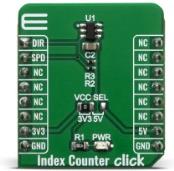
|
|
Index Counter Click is a simple prototyping high precision Hall-Effect switch solution with direction detection. This board is hosting TLE4966K an integrated circuit dual Hall-effect sensor from Infineon. The sensor is designed specifically for highly accurate applications which use a rotating pole wheel since offers high sensitivity and high stability of the magnetic switching points. Since this sensor is based on two hall probes that provide information about direction and speed of the moving wheel, this makes this product excellent choice for applications such as index counting, rotational speed and direction applications, motor driven position systems.
Index Counter Click is supported by a mikroSDK compliant library, which includes functions that simplify software development. This Click board™ comes as a fully tested product, ready to be used on a system equipped with the mikroBUS™ socket.
|
|
|
|
 |

|
|
Expand 8 Click is a compact add-on board that contains a multi-port I/O expander with bi-directional input/outputs. This board features the MAX7317, 10-Port SPI-interfaced I/O expander with overvoltage and hot-insertion protection from Maxim Integrated. The MAX7317 provides microprocessors with 10 I/O ports rated to 7V. Each port can be individually configured as either an open-drain output or an overvoltage-protected Schmitt input that supports hot insertion. All port pins remain high impedance in Power-Down mode with up to 8V asserted on them. This Click board™ is intended for use as a port expander in system monitoring applications, industrial controllers, portable equipment, and many more.
Expand 8 Click is supported by a mikroSDK compliant library, which includes functions that simplify software development. This Click board™ comes as a fully tested product, ready to be used on a system equipped with the mikroBUS™ socket.
|
|
|
|
 |

|
|
RF Switch Click is a Click board™ equipped with the MASWSS0115, a GaAs PHEMT MMIC single-pole, double-throw (SPDT) switch developed by Macom for switching between small signal components such as filter banks, single-band LNAs, converters, etc. The MASWSS0115 is ideally suited for applications where a very small size and low cost are required. RF Switch Click can be used for low power, low loss requirements in all systems operating up to 3 GHz, including PCS, GSM, DCS, Bluetooth, and other receive chain applications. The Click board includes additional drivers in the form of a complementary control and power switch for safe switching operations. RF Switch Click provides easy signal switching with an insertion loss of 0.3 dB at 2.4 GHz and maximum power consumption of 20µA.
The RF Switch Click is supported by a mikroSDK compliant library, which includes functions that simplify software development. This Click board™ comes as a fully tested product, ready to be used on a system equipped with the mikroBUS™ socket.
|
|
|
|
 |
|

